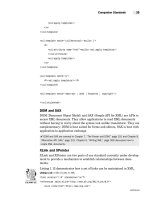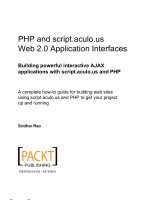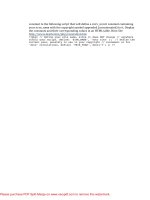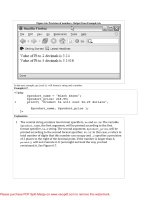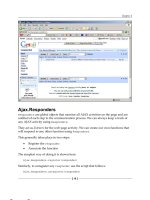Tài liệu PHP and MySQL by Example- P2 pdf
Bạn đang xem bản rút gọn của tài liệu. Xem và tải ngay bản đầy đủ của tài liệu tại đây (1.38 MB, 50 trang )
Table 3.1. PHP Syntax and Constructs
!"#$%&'( !"#$)*)$(+,-.%$-($./&+#0$1#%2##3$%"#$)*)$4.#3$%&'$
<?php
$&30$%"#$)*)$+/4(#$
%&'$
?>
5$!"#$+40#$1#%2##3$%"#(#$%24$%&'($-($2"&%$%"#$)*)$6407/#$.,4+#((#(5$
!"#$*!89$+40#$-($:7(%$/#;%$&($-($<(##$="&.%#,$>?$@A#%%-3'$B%&,%#0CD5
Instantiating a class:
$cat = new Pet; // Create object with a
constructor method
$cat->set_name("Sneaky"); // Access object
with an instance method
echo "Your cat is rightly named ",$cat->get_name(),
".<br";
?>
$ )*)$&/(4$(7..4,%($-3"#,-%&3+#5$G$3#2$+/&(($+&3$1#$+,#&%#0$;,46$&3$#Q-(%-3'$
+/&((?$&$.&,#3%b+"-/0$,#/&%-43("-.$2"#,#$%"#$+"-/0$+/&(($-3"#,-%($.,4.#,%-#($&30$
6#%"40($4;$%"#$.&,#3%$+/&(($&30$#Q%#30($4,$0#;-3#($%"#$;73+%-43&/-%H$4;$-%($
.&,#3%5$)*)$&/(4$"&($(.#+-&/$+43(%,7+%4,$&30$0#(+%,7+%4,$6#%"40($;4,$+,#&%-3'$
&30$0#(%,4H-3'$41:#+%(?$&($2#//$&($(.#+-&/$(#%%#,$&30$'#%%#,$6#%"40($<&/(4$
+&//#0$&++#(($4,$-3(%&3+#$6#%"40(D$;4,$&((-'3-3'$&30$,#%,-#L-3'$%"#$41:#+%c($
.,4.#,%-#(5$G3$#Q&6./#$%"&%$+,#&%#($&$3#2$
Laptop
$+/&(($;,46$&$
Computer
$+/&(($
-($("423$"#,#5
$ EFG8)9E
$ =40#$P-#2I$$
<?php
class computer {
private $password; // Visible only within this class
protected $userId; // Visible within this
class and subclass
public $printer; // Visible anywhere in the
script
function __construct() { // Parent's
constructor
print "In the parent constructor.\n<br />";
$this->userId = "willie"; // protected
Please purchase PDF Split-Merge on www.verypdf.com to remove this watermark.
Table 3.1. PHP Syntax and Constructs
!"#$%&'( !"#$)*)$(+,-.%$-($./&+#0$1#%2##3$%"#$)*)$4.#3$%&'$
<?php
$&30$%"#$)*)$+/4(#$
%&'$
?>
5$!"#$+40#$1#%2##3$%"#(#$%24$%&'($-($2"&%$%"#$)*)$6407/#$.,4+#((#(5$
!"#$*!89$+40#$-($:7(%$/#;%$&($-($<(##$="&.%#,$>?$@A#%%-3'$B%&,%#0CD5
$this->password = "urAok5"; // private
}
function setUserId($userId){
$this->userId=$userId;
}
function getUserId() {
return $this->userId;
}
private function setPassword($password){ // private
method
$this->password=$password;
}
private function getPassword(){
return $this->password;
}
}
class Laptop extends Computer{ //
Child/derived/subclass
public $brand;
public $weight;
private $password="LetMeIn2";
function __construct($brand,$weight){ // Subclass
constructor
parent::__construct(); // Call to parent's
constructor
echo "Child constructor just called.\n<br />";
$this->brand=$brand; // new properties for
the child
$this->weight=$weight;
}
}
function __destruct(){
echo "$this being destroyed\n";
}
function setPassword($password){
$this->password=$password;
}
function getPassword(){
return $this->password;
}
}
Please purchase PDF Split-Merge on www.verypdf.com to remove this watermark.
Table 3.1. PHP Syntax and Constructs
!"#$%&'( !"#$)*)$(+,-.%$-($./&+#0$1#%2##3$%"#$)*)$4.#3$%&'$
<?php
$&30$%"#$)*)$+/4(#$
%&'$
?>
5$!"#$+40#$1#%2##3$%"#(#$%24$%&'($-($2"&%$%"#$)*)$6407/#$.,4+#((#(5$
!"#$*!89$+40#$-($:7(%$/#;%$&($-($<(##$="&.%#,$>?$@A#%%-3'$B%&,%#0CD5
// Class user
$pc=new Computer(); // Create two new objects
$portable = new Laptop();
$portable->setPassword("letmein2");
.....
]-/#( )*)$+46#($2-%"$&$(#%$4;$17-/%S-3$;73+%-43($%"&%$&//42$H47$%4$24,U$2-%"$;-/#(5$
d47$+&3$-3+/70#$#Q%#,3&/$;-/#($2-%"$%"#$
require
$&30$
include
$(%&%#6#3%(5$!"#$
-3+/70#0$;-/#($+&3$+43(-(%$4;$)*)?$*!89?$F89?$%#Q%?$&30$(4$435$!"#$,#K7#(%#0$
;-/#c($+43%#3%($,#./&+#$%"#$/-3#$+43%&-3-3'$%"#$24,0$
require
$4,$
include
5
$ EFG8)9E
$ !4$-3+/70#$&$;-/#I$$
// replaces instances of require with the contents of
file
require("copyright.inc");
// replaces only first instance of require with
contents of file
require_once("header.inc");
// same as replace but happens only during program
execution
include("disclaimer.inc");
// happens only once during program execution
include_once("title.inc");
$ !4$4.#3$&$;-/#$;4,$,#&0-3'?$2,-%-3'?$&..#30-3'?$&30$(4$43?$%"#$;-/#3&6#$67(%$1#$
&((-'3#0$%4$&$;-/#"&30/#5$!"#$;4//42-3'$-($&$/-(%$4;$(46#$4;$%"#$1&(-+$;73+%-43($
;4,$4.#3-3'?$+/4(-3'?$,#&0-3'?$&30$2,-%-3'$%4$&$;-/#5
$ EFG8)9EB
$ !4$4.#3$&$;-/#I$
=40#$P-#2I$
// Opens "filename" for reading
$filehandle = fopen("filename", "r");
// Opens "filename" for writing
$filehandle = fopen("filename", "w");
// Opens "filename" for binary writing
Please purchase PDF Split-Merge on www.verypdf.com to remove this watermark.
Table 3.1. PHP Syntax and Constructs
!"#$%&'( !"#$)*)$(+,-.%$-($./&+#0$1#%2##3$%"#$)*)$4.#3$%&'$
<?php
$&30$%"#$)*)$+/4(#$
%&'$
?>
5$!"#$+40#$1#%2##3$%"#(#$%24$%&'($-($2"&%$%"#$)*)$6407/#$.,4+#((#(5$
!"#$*!89$+40#$-($:7(%$/#;%$&($-($<(##$="&.%#,$>?$@A#%%-3'$B%&,%#0CD5
$filehandle = fopen("filename", "wb");
To close a file:
fclose($filehandle);
To read from a file:
// Reads a line from file attached to $filehandle
$string = fgets($filehandle);
// Reads a character from file attached to $filehandle
$char = fgetc($filehandle);
// Reads chunk of bytes from file attached to
$filehandle
$text = fread($filehandle, $bytes );
// Reads entire contents from "filename"
$text = file_get_contents("filename");
To write to a file:
// Writes $string to $filehandle
fwrite($filehandle, $string);
// Writes $string to "filename"
file_put_contents("filename", $string);
e#'7/&,$
#Q.,#((-43(
)*)$(7..4,%($.&%%#,3$6&%+"-3'$2-%"$,#'7/&,$#Q.,#((-43($&30$,#'7/&,$
#Q.,#((-43$6#%&+"&,&+%#,($<(##$!&1/#$f5>D5$!"#$
pcre
$<)#,/$(%H/#D$;73+%-43($&,#$
7(#0$%4$%#(%$2"#%"#,$&$%#Q%$(%,-3'$6&%+"#($&$.&%%#,35
$ EFG8)9EB
$ =40#$P-#2I$
// $result is 1, $matches contains needle
$result = preg_match("/needle/", "looking for a
needle in a
haystack", $matches);
// Regular expression metacharacters
if ( preg_match("/^[Nn]..dle/", "Needle in a haystack"
)){
echo "Found match.\n";
}
// $new_array contains: normal, mama, man
$new_array = preg_grep("/ma/", array("normal", "mama",
"man","plan"));
// $new_array contains: plan
$new_array =
Please purchase PDF Split-Merge on www.verypdf.com to remove this watermark.
Table 3.1. PHP Syntax and Constructs
!"#$%&'( !"#$)*)$(+,-.%$-($./&+#0$1#%2##3$%"#$)*)$4.#3$%&'$
<?php
$&30$%"#$)*)$+/4(#$
%&'$
?>
5$!"#$+40#$1#%2##3$%"#(#$%24$%&'($-($2"&%$%"#$)*)$6407/#$.,4+#((#(5$
!"#$*!89$+40#$-($:7(%$/#;%$&($-($<(##$="&.%#,$>?$@A#%%-3'$B%&,%#0CD5
preg_grep("/ma/",array("normal","mama","man",
"plan"),PREG_GREP_INVERT);
// $new_string: "I am feeling upbeat, upbeat, upbeat."
$new_string = preg_replace("/blue/", "upbeat", "I am
feeling
blue, blue, blue.");
// $new_string: "I am feeling upbeat, blue, blue"
$new_string = preg_replace("/blue/", "upbeat", "I am
feeling
blue, blue, blue.",1);
// $new_string: "I am feeling upbeat, upbeat.
$new_string = preg_replace("/blue/i", "upbeat", "I am
feeling
BLue, BLUE.");
// $new_string: "War and Peace"
$new_string = preg_replace("/(Peace) and (War)/i", "$2
and $1",
"Peace and War");
// $new_string: "He gave me 42 dollars."
$new_string = preg_replace("/5/e", "6*7", "He gave me 5
dollars.")e;
$
$
$
$
$
$
Please purchase PDF Split-Merge on www.verypdf.com to remove this watermark.
Table 3.2. Some Regular Expression Metacharacters
Metacharacter What)It)Does
^
8&%+"#($&%$%"#$1#'-33-3'$4;$&$/-3#
$
8&%+"#($&%$%"#$#30$4;$&$/-3#
a.c
8&%+"#($&3$
a
?$&3H$(-3'/#$+"&,&+%#,?$&30$&$
c
[abc]
8&%+"#($&3$
a
$4,$
b
$4,$
c
[^abc]
8&%+"#($&$+"&,&+%#,$%"&%$-($34%$&3$
a
?$4,$
b
?$4,$
c
[0-9]
8&%+"#($43#$0-'-%$1#%2##3$
0
$&30$
9
ab*c
8&%+"#($&3$
a
?$;4//42#0$1H$Y#,4$4,$64,#$4;$%"#$/#%%#,$
b
?$&30$&$
c
ab+c
8&%+"#($&3$
a
?$;4//42#0$1H$43#$4,$64,#$4;$%"#$/#%%#,$
b
?$&30$&$
c
ab?c
8&%+"#($&3$
a
?$;4//42#0$1H$Y#,4$4,$43#$
b
?$&30$&$
c
$
At the end of each section, you are given the chapter number that describes the particular construct and a short, fully
functional PHP example designed to illustrate how that constuct is used.
3.1.2. A Note to Nonprogrammers
If you are not familiar with programming, skip this chapter and go to Chapter 4, “The Building Blocks.” You might
want to refer to this chapter later for a quick reference.
3.1.3. PHP Syntax and Constructs
3.2. Chapter Summary
This chapter was provided for programmers who need a quick peek at what PHP looks like, its general syntax, and
programming constructs. Later, this chapter can serve as a tutorial to refresh your memory without having to search
through the index to find what you are looking for.
3.2.1. What’s Next?
In Chapter 4, “The Building Blocks,” we discuss the basic building blocks of all languages: data types. You learn how
to work with different types of numbers, strings, booleans, and more.
You also learn how to define and display variables, how to use variables, how PHP deals with data coming in from
HTML forms, and how to define constants.
$
Please purchase PDF Split-Merge on www.verypdf.com to remove this watermark.
Chapter 4. The Building Blocks: Data Types, Literals, Variables, and Constants
“One man’s constant is another man’s variable.”
—Alan Perlis
4.1. Data Types
A program can do many things, including perform calculations, sort names, prepare phone lists, display images, play
chess, ad infinitum. To do anything, however, the program works with the data that is given to it. Data types specify
what kind of data, such as numbers and characters, can be stored and manipulated within a program. PHP supports a
number of fundamental basic data types, such as integers, floats, and strings. Basic data types are the simplest building
blocks of a program. They are called scalars and can be assigned a single literal value such as a number, 5.7, or a
string of characters, such as "hello", a date and time, or a boolean (true/false). See Figure 4.1.
Figure 4.1. Scalars hold one value.
!
PHP also supports composite data types, such as arrays and objects. Composite data types represent a collection of data,
rather than a single value (see Figure 4.2). The composite data types are discussed in Chapter 8, “Arrays,” and Chapter
17, “Objects.”
Figure 4.2. Arrays and objects hold multiple values.
!
Please purchase PDF Split-Merge on www.verypdf.com to remove this watermark.
The different types of data are commonly stored in variables. Examples of PHP variables are $num = 5 or $name =
"John" where variables $num and $name are assigned an integer and a string, respectively. Variables hold values
that can change throughout the program, whereas once a constant is defined, its value does not change. PHP_VERSION
and PHP_OS are examples of predefined PHP constants. The use of PHP variables and constants is addressed in
“Variables” on page 70 and “Constants” on page 99 of this chapter.
PHP supports four core data types:
• Integer
• Float (also called double)
• String
• Boolean
In addition to the four core data types, there are four other special types:
• Null
• Array
• Object
• Resources
4.1.1. Numeric Literals
PHP supports both integers and floating-point numbers. See Example 4.1.
• Integers— Integers are whole numbers and do not contain a decimal point; for example, 123 and –6. Integers
can be expressed in decimal (base 10), octal (base 8), and hexadecimal (base 16), and are either positive or
negative values.
• Floating-point numbers— Floating-point numbers, also called doubles or reals, are fractional numbers such as
123.56 or –2.5. They must contain a decimal point or an exponent specifier, such as 1.3e–2. The letter “e” can
be either upper or lowercase.
PHP numbers can be very large (the size depends on your platform), but a precision of 14 decimal digits is a common
value or (~1.8e
308
).
Example 4.1.
12345 integer
23.45 float
.234E–2 float in scientific notation
.234e+3 float in scientific notation
0x456fff integer in base 16, hexadecimal
0x456FFF integer in base 16, hexadecimal
0777 integer in base 8, octal
Example 4.2.
<html>
<head><title>Printing Numbers</title>
</head>
<body bgcolor="lightblue">
<font face = "arial" size = '+1'>
<?php
print "The positive integer is <em><b>" . 5623 . "
.</b></em><br />";
print "The negative integer is <em><b>" . -22 . ".</b></em><br
/>";
print "The floating point number is <em><b>" . 15.3 . "
.</b></em><br />";
print "The number in scientfic notation is <em><b> " . 5e3 . "
. </b></em><br />";
print "\tThe string is: <em><b>I can't help you!</em>
</b><br />";
Please purchase PDF Split-Merge on www.verypdf.com to remove this watermark.
?>
</body>
</html>
Figure 4.3. Output from Example 4.2.
!
!
!
4.1.2. String Literals and Quoting
We introduce strings in this chapter but Chapter 6, “Strings,” provides a more comprehensive coverage. String literals
are a row of characters enclosed in either double or single quotes.
[1]
The quotes must be matched. If the string starts with
a single quote, it must end with a matching single quote; likewise if it starts with a double quote, it must end with a
double quote. If a string of characters is enclosed in single quotes, the characters are treated literally (each of the
characters represents itself). We can say the single quotes are the democratic quotes: All characters are treated equally.
[1]
PHP always null-terminates strings internally and keeps track of the length of the string.
Double quotes do not treat all characters equally. If a string is enclosed in double quotes, most of the characters
represent themselves, but dollar signs and backslashes have a special meaning as shown in the following examples.
Single quotes can hide double quotes, and double quotes can hide single quotes:
[2]
[2]
PHP recognizes editors that use straight quotes, such as vi or Notepad, but not editors that automatically transform
straight quotes into curly quotes.
"This is a string" 'This is another string' "This is also 'a string'" 'This is
"a string"'
!
An empty set of quotes is called the null string. If a number is enclosed in quotes, it is considered a string; for example,
"5" is a string, whereas 5 is a number.
Strings are called constants or literals. The string value "hello" is called a string constant or literal. To change a
string requires replacing it with another string.
Strings can contain escape sequences (a single character preceded with a backslash). Escape sequences cause a
character to behave in a certain way; for example, a "\t" represents a tab and "\n" represents a newline. The
backslash is also used for quoting a single character so that it will not be interpreted; for example, \$5.00 where the
dollar sign in PHP is used to represent variables rather than money. \$5.00 could also be written as '$5' because
single quotes protect all characters from interpretation.
Here documents, also called here-docs, provide a way to create a block of text that simplifies writing strings containing
lots of single quotes, double quotes, and variables (see Example 4.4).
Please purchase PDF Split-Merge on www.verypdf.com to remove this watermark.
Example 4.3.
<html>
<head><title>Quotes</title></head>
<body bgcolor="lightblue"><font size='+1'>
1 <?php
2 $name = "Nancy"; // Setting a PHP variable
print "<ol>";
3 print "<li> $name is my friend.</li>"; // Double
quotes
4 print '<li> $name is my neighbor.</li>'; // Single
quotes
5 print "<li> I can't go with you.</li>"; // Nested
quotes
6 print "<li> She cried, \"Help!\"</li>"; // Escaping
quotes
7 print "<li> I need \$5.00.</li>"; // The backslash
// quotes one
character
8 print "<li> $name needs ". '$5.00 </li>'; // Nested
quotes
print "</ol>";
?>
</body>
</html>
Explanation
" #$#!%&'(&)*!+,)&,+!-.&./
0
$name
!1+!)!#$#!2)&1)34./!5,!1+!)++1(6.7!,-.!+,&16(!
"Nancy"
/!8'9!:144!4.)&6!)44!
)3'9,!2)&1)34.+!16!,-.!+.;,1'6!<=)&1)34.+>!'6!%)(.!?@/
A B-.6!)!+,&16(!1+!.6;4'+.7!:1,-16!7'934.!C9',.+D!,-.!#$#!16,.&%&.,.&!:144!
+93+,1,9.!,-.!2)&1)34.!:1,-!1,+!2)49.E!F'&!.G)*%4.D!
$name
!:144!3.!&.%4);.7!:1,-!
"Nancy"
/
H B-.6!)!+,&16(!1+!.6;4'+.7!16!+16(4.!C9',.+D!)44!;-)&);,.&+!)&.!,&.),.7!)+!41,.&)4+/!
=)&1)34.!+93+,1,9,1'6!:144!6',!';;9&/
I J16(4.!C9',.+!;)6!3.!6.+,.7!:1,-16!7'934.!C9',.+!)67!21;.!2.&+)/
K L9',.+!;)6!3.!.+;)%.7!:1,-!)!3);M+4)+-!,'!*)M.!,-.*!41,.&)4!;-)&);,.&+!:1,-16!
)!+,&16(/
? N-.!7'44)&!+1(6!1+!.+;)%.7!F&'*!#$#!16,.&%&.,),1'6D!,-),!1+D!1+!,&.),.7!)+!)!
41,.&)4!;-)&);,.&/
O P!+,&16(!16!7'934.!C9',.+!1+!;'6;),.6),.7!,'!)!+,&16(!16!+16(4.!C9',.+/!Q9+,!)+!
,-.!3);M+4)+-!%&',.;,+!,-.!7'44)&!+1(6!F&'*!16,.&%&.,)1'6D!+'!7'!,-.!+16(4.!
C9',.+/!R.*.*3.&D!;-)&);,.&+!16!+16(4.!C9',.+!)&.!)44!,&.),.7!)+!41,.&)4+E!,-),!
1+D!#$#!7'.+!6',!;'6+17.&!)6S!'F!,-.!.6;4'+.7!;-)&);,.&+!)+!+%.;1)4/!J..!,-.!
'9,%9,!16!T1(9&.!H/H/
Please purchase PDF Split-Merge on www.verypdf.com to remove this watermark.
C9',.+/!R.*.*3.&D!;-)&);,.&+!16!+16(4.!C9',.+!)&.!)44!,&.),.7!)+!41,.&)4+E!,-),!
1+D!#$#!7'.+!6',!;'6+17.&!)6S!'F!,-.!.6;4'+.7!;-)&);,.&+!)+!+%.;1)4/!J..!,-.!
'9,%9,!16!T1(9&.!H/H/
!
Figure 4.4. Single and double quotes.
The Here Document—A Special Kind of Quoting
Here documents are a kind of quoting popular in a number of languages, such as JavaScript, Perl, Shell scripts, and so
on. Here documents, also called here-docs, allow you to quote a large block of text within your script without using
multiple print statements and quotes. The entire block of text is treated as though it is surrounded by double quotes.
This can be useful if you have a large block of HTML within your PHP script interspersed with variables, quotes, and
escape sequences.
Rules for a Here Document:
1.# N-.!9+.&U7.F16.7!7.41*1,.&!:'&7!+,)&,+!)67!,.&*16),.+!,-.!-.&.!7';9*.6,/!N.G,!1+!
16+.&,.7!3.,:..6!,-.!7.41*1,.&+/!N-.!7.41*1,.&!;)6!;'6,)16!4.,,.&+D!69*3.&+D!)67!,-.!
967.&+;'&.!;-)&);,.&/!N-.!F1&+,!4.,,.&!*9+,!3.!)!4.,,.&!'&!)6!967.&+;'&./!VS!;'62.6,1'6D!
,-.!7.41*1,.&!+-'947!3.!16!)44!9%%.&;)+.!4.,,.&+!,'!*)M.!1,!+,)67!'9,!F&'*!',-.&!:'&7+!16!
S'9&!+;&1%,/!N-.!7.41*.,.&!1+!%&.;.7.7!3S!,-&..!W!;-)&);,.&+E!F'&!.G)*%4.D!
<<<DELIMITER
!
print <<<HERE_DOC_DELIMITER <text here> ... < more text> ...
HERE_DOC_DELIMITER
2.# N-.!7.41*1,.&!;)66',!3.!+9&&'967.7!3S!)6S!+%);.+D!;'**.6,+D!'&!',-.&!,.G,/!N-.!F16)4!
7.41*1,.&!;)6!'%,1'6)44S!3.!,.&*16),.7!:1,-!)!+.*1;'4'6!)67!*9+,!3.!'6!)!416.!3S!1,+.4F/
3.# P44!2)&1)34.!)67!.+;)%.!+.C9.6;.+!:144!3.!16,.&%&.,.7!:1,-16!,-.!-.&.!7';9*.6,/
Please purchase PDF Split-Merge on www.verypdf.com to remove this watermark.
Example 4.4.
1 <?php
2 $bgcolor="darkblue";
$tablecolor = "yellow";
3 print <<< MY_BOUNDARY
4 <html><head><title>heredoc</title></head>
5 <body bgcolor="$bgcolor">
6 <table border="1" bgcolor=$tablecolor>
<tr><th>Author</th<th>Book</th></tr>
<tr>
<td>Marcel Proust</td>
<td>Remembrance of Things Past</td>
</tr>
<tr>
<td>Charles Dickens</td>
<td>Tale of Two Cities</td>
</tr>
</table>
</body>
7 </html>
8 MY_BOUNDARY;
?>
Explanation
" #$#!+,)&,+!-.&./
0 N:'!+;)4)&!2)&1)34.+!)&.!7.F16.7/
A N-1+!1+!,-.!-.&.U7';/!N-.!9+.&U7.F16.7!,.&*16),'&D!
MY_BOUNDARY
D!1+!%&.%.67.7!
:1,-!
<<<
/!N-.&.!;)6!3.!6'!+%);.!)F,.&!,-.!,.&*16),'&E!',-.&:1+.!)6!.&&'&!41M.!
,-1+!:144!3.!71+%4)S.7X!#)&+.!.&&'&X!+S6,)G!.&&'&D!96.G%.;,.7!NYJZ!16!
;X[:)*%[:::[.G.*%4.+[;-H2)&1)34.+[-.&.7';/%-%!'6!416.!H
H P44!'F!,-.!$N\Z!7';9*.6,!1+!.*3.77.7!16!,-.!-.&.!7';9*.6,/!N-.!$N\Z!:144!
3.!+.6,!,'!,-.!3&':+.&!)+!1+/!P6S!#$#!;'7.!.*3.77.7!:1,-16(!,-.!$N\Z!,)(+!
:144!3.!-)674.7!3S!,-.!#$#!16,.&%&.,.&/
I N-.!2)49.!'F!,-.!2)&1)34.D!
$bgcolor
D!:144!3.!)++1(6.7!)+!,-.!3);M(&'967!;'4'&!
'F!,-.!%)(./
K P6!$N\Z!,)34.!1+!+,)&,.7!-.&./!N-.!2)49.!'F!,-.!2)&1)34.D!
$tablecolor
D!:144!3.!
)++1(6.7!)+!,-.!3);M(&'967!;'4'&!'F!,-.!,)34.!;.44+/
? N-.!$N\Z!7';9*.6,!.67+!-.&.D!16+17.!,-.!-.&.U7';/
O N-.!9+.&U7.F16.7!,.&*16),'&D!
MY_BOUNDARY
D!*)&M+!,-.!.67!'F!,-.!-.&.!
7';9*.6,/!N-.&.!;)6!3.!6'!+%);.+!+9&&'96716(!,-.!,.&*16),'&/!N-.!+.*1;'4'6!
1+!'%,1'6)4/
Please purchase PDF Split-Merge on www.verypdf.com to remove this watermark.
Figure 4.5. Here document output.
!
Escape Sequences
Escape sequences consist of a backslash followed by a single character. When enclosed in double quotes, the backslash
causes the interpretation of the next character to “escape” from its normal ASCII code and to represent something else
(see Table 4.1). To display the escape sequences in your browser, the HTML <pre> tag can be used (see Example
4.5); otherwise, the escape sequences placed within your PHP script will not be interpreted.
Table 4.1. Escape Sequences
Escape#Sequence What#It#Represents
\'
J16(4.!C9',),1'6!*)&M
\"
]'934.!C9',),1'6
\t
N)3
\n
^.:416.
\r
R.,9&6_416.!F..7
\$
P!41,.&)4!7'44)&!+1(6
\\
V);M+4)+-
\70
R.%&.+.6,+!,-.!';,)4!2)49.
\x05
R.%&.+.6,+!,-.!-.G)7.;1*)4!;-)&);,.&
!
Example 4.5.
<html><head><title>Escape Sequences</title></head>
<body bgcolor="orange">
<b>
1 <pre>
2 <?php
Please purchase PDF Split-Merge on www.verypdf.com to remove this watermark.
3 print "\t\tTwo tabs are \\t\\t, and two newlines are
\\n\\n.\n\n";
4 print "\tThe escaped octal numbers represent ASCII
\101\102\103.\n";
print "\tThe escaped hexadecimal numbers represent ASCII
\x25\x26.\n";
5 print '\tWith single quotes, backslash sequences are not
interpreted.\n';
?>
</pre>
</b>
</body>
</html>
Explanation
" V.;)9+.!,-1+!F14.!:144!3.!71+%4)S.7!16!)!3&':+.&!:167':D!,-.!$N\Z!
<pre>
!,)(+!)&.!9+.7!
,'!&.,)16!+%);.+!)67!,)3+/!5F!S'9!&96!#$#!),!,-.!;'**)67!416.D!,-.!.+;)%.!+.C9.6;.+!:144!
3.!16,.&%&.,.7/
0 N-.!#$#!%&'(&)*!+,)&,+!-.&.!:1,-!1,+!'%.616(!,)(/
A N-.!.+;)%.!+.C9.6;.+!*9+,!3.!.6;4'+.7!16!7'934.!C9',.+/!N-.!+.C9.6;.+!F'&!,)3!`
\t
a!
)67!6.:416.!`
\n
a!;-)&);,.&+!%&'79;.!,)3+!)67!6.:416.+/!5F!)!3);M+4)+-!1+!%&.%.67.7!
:1,-!)6',-.&!3);M+4)+-D!,-.6!,-.!3);M+4)+-!1+!,&.),.7!)+!)!41,.&)4/
H 56!,-1+!.G)*%4.D!3S!%&.;.716(!)6!';,)4!'&!-.G)7.;1*)4!69*3.&!:1,-!)!3);M+4)+-D!1,+!
PJb55!.C912)4.6,!1+!71+%4)S.7/
I 5F!)!+,&16(!1+!.6;4'+.7!16!+16(4.!C9',.+D!.+;)%.!+.C9.6;.+!)&.!1(6'&.7/!J..!,-.!'9,%9,!16!
T1(9&.!H/K/
!
Figure 4.6. Escape sequences and the <pre> tag.
!
!
Please purchase PDF Split-Merge on www.verypdf.com to remove this watermark.
Figure 4.7. Escape sequences at the command line.
!
!
!
4.1.3. Boolean Literals
Boolean literals (introduced in PHP 4) are logical values that have only one of two values, true or false, both case
insensitive. You can think of the values as yes or no, on or off, or 1 or 0. They are used to test whether a condition is
true or false. When using numeric comparison and equality operators, the value true evaluates to 1 and false evaluates
to the empty string (see Figure 4.8).
$answer1 = true; or if ($answer2 == false) { do something; }
!
Example 4.6.
<?php
if ( 0 == False && "" == FALSE) {
print "zero and the empty string are <em>false,</em><br /> ";}
if ( 1 == True && "abc" == true) {
print "1 and \"abc\" are both <em>true.</em><br /> "; }
?>
Figure 4.8. True and false.
!
4.1.4. Special Data Types
Null
NULL represents “no value,” meaning “nothing,” not even an empty string or zero. It is a type of NULL. An
uninitialized variable contains the value NULL. A variable can be assigned the value NULL, and if a variable has been
unset, it is considered to be NULL.
Please purchase PDF Split-Merge on www.verypdf.com to remove this watermark.
Resource
A resource is a special variable, holding a reference to an external resource such as a database object or file handler.
Resources are created and used by special functions. File and database resources are defined by the PHP interpreter and
are only accessible by functions provided by the interpreter (see Chapter 11, “Files and Directories,” and Chapter 15,
“PHP and MySQL Integration).
The gettype() Function
The gettype() built-in function returns a string to identify the data type of its argument. The argument might be a
variable, string, keyword, and so on. You can use the gettype() function to check whether or not a variable has been
defined because if there is no value associated with the variable, the gettype() function returns NULL (see Figure
4.9).
Figure 4.9. PHP data types. Output from Example 4.7.
!
Strings returned from the gettype() function include the following:
"boolean" (since PHP 4)
"integer"
"double" (for historical reasons "double" is returned in case of a float, and not simply "float")
"string"
"array"
"object"
"resource" (since PHP 4)
"NULL" (since PHP 4)
Format
string gettype ( mixed var )
!
Examples:
$type=gettype(54.6); // Returns "float" print gettype("yes"); // Returns and
prints "string"
Please purchase PDF Split-Merge on www.verypdf.com to remove this watermark.
Example 4.7.
<html>
<head><title>Getting the Data Type with gettype()</title>
</head><body bgcolor="lightblue">
<font face = "arial" size = '+1'>
<pre>
<?php
print "Type <b>5623</b> is: " . gettype(5623) . ".\n";
print "Type <b>-22</b> is: " . gettype(-22) . ".\n";
print "Type <b>15.3</b> is: " . gettype(15.3) . ".\n";
print "Type <b>5e3</b> is: " . gettype(5e3) . ".\n";
print "Type <b>\"Hi\"</b> is: " . gettype("Hi") . ".\n";
print "Type <b>true</b> is: " . gettype(true) . ".\n";
print "Type <b>false</b> is: " . gettype(false) . ".\n";
print "Type <b>null</b> is: " . gettype(null) . ".\n";
print "Type <b>\$nothing</b> is: " . gettype($nothing) . ".\n";
?>
</body>
</html>
4.2. Variables
4.2.1. Definition and Assignment
Variables are fundamental to all programming languages. They are data items that represent a memory storage location
in the computer. Variables are containers that hold data such as numbers and strings. In PHP programs there are three
types of variables:
1.# #&.7.F16.7!2)&1)34.+
2.# c+.&U7.F16.7!2)&1)34.+
3.# T'&*!2)&1)34.+!&.4),.7!,'!6)*.+!16!)6!$N\Z!F'&*
Variables have a name, a type, and a value.
$num = 5; // name: "$num", value: 5, type: numeric $friend =
"Peter"; // name: "$friend", value: "Peter", type: string $x = true;
// name: "$x", value: true, type: boolean
!
The values assigned to variables can change throughout the run of a program whereas constants, also called literals,
remain fixed.
PHP variables can be assigned different types of data, including:
• Numeric
• String
• Boolean
• Objects
• Arrays
Computer programming languages like C++ and Java require that you specify the type of data you are going to store in
a variable when you declare it. For example, if you are going to assign an integer to a variable, you would have to say
something like:
int n = 5;
!
Please purchase PDF Split-Merge on www.verypdf.com to remove this watermark.
and if you were assigning a floating-point number:
float x = 44.5;
!
Languages that require that you specify a data type are called “strongly typed” languages. PHP, conversely, is a
dynamically, or loosely typed, language, meaning that you do not have to specify the data type of a variable. In fact,
doing so will produce an error. With PHP you would simply say:
$n = 5; $x = 44.5;
!
and PHP will figure out what type of data is being stored in $n and $x.
4.2.2. Valid Names
Variable names consist of any number of letters (an underscore counts as a letter) and digits. The first letter must be a
letter or an underscore (see Table 4.2). Variable names are case sensitive, so Name, name, and NAme are all different
variable names.
Table 4.2. Valid and Invalid Variable Name Examples
Valid#Variable#Names Invalid#Variable#Names
$name1
$10names
$price_tag
box.front
$_abc
$name#last
$Abc_22
A-23
$A23
$5
4.2.3. Declaring and Initializing Variables
Variables are normally declared before they are used. PHP variables can be declared in a script, come from an HTML
form, from the query string attached to the script’s URL, from cookies, from the server, or from the server’s
environment. Variable names are explicitly preceded by a $. You can assign a value to the variable (or initialize a
variable) when you declare it, but it is not mandatory.
Format
$variable_name = value; initialized $variable_name; uninitialized, value
is null
To declare a variable called firstname, you could say:
$first_name="Ellie";
!
You can declare multiple variables on the same line by separating each declaration with a semicolon. For example, you
could say:
$ first_name; $middle_name; $last_name;
!
Double, Single, and Backquotes in Assignment Statements
When assigning a value to a variable, if the value is a string, then the string can be enclosed in either single or double
quotes; if the value is returned from a function, then the function is not enclosed in quotes; and if the value is returned
from a system command (see “Execution Operators” on page 143), then the command is enclosed in backquotes:
$name = "Marko"; // Assign a string $city = 'San Francisco'; // Assign a
string $now = date("m/d/Y"); // Assign output of a function $dirlist = 'ls -l';
// Assign output of a UNIX/Linux system command $dirlist = 'dir /D/L' // Assign
a Windows system command
Please purchase PDF Split-Merge on www.verypdf.com to remove this watermark.
!
Example 4.8.
<html>
<head><title>Variables</title></head>
<body bgcolor="lightblue">
<font face = "arial" size='+1'>
<?php
1 $name="Joe Shmoe";
2 $age=25.4;
3 $now=date("m/d/Y");
4 $nothing;
5 echo "$name is $age years old.<br />";
6 echo '$nothing contains the value of ', gettype($nothing),
".<br />";
7 echo "Today is $now<br />";
?>
</font>
</body>
</html>
Explanation
" N-.!2)&1)34.!;)44.7!
$name
!1+!7.F16.7!)67!161,1)41d.7!:1,-16!,-.!+,&16(!2)49.!
"Joe Shmoe"
/!
N-.!+,&16(!;)6!3.!.6;4'+.7!16!.1,-.&!+16(4.!'&!7'934.!C9',.+/
0 N-.!2)&1)34.!;)44.7!
$age
!1+!)++1(6.7!,-.!F4'),16(U%'16,!2)49.D!
25.4
/!B-.6!)++1(616(!)!
69*3.&D!,-.!2)49.!1+!6',!C9',.7/
A N-.!2)&1)34.!;)44.7!
$now
!1+!)++1(6.7!,-.!&.,9&6!2)49.!'F!,-.!3914,U16!
date()
!F96;,1'6/!N-.!
F96;,1'6!1+!6',!.6;4'+.7!16!C9',.+!'&!1,!:144!6',!3.!.G.;9,.7/!5,+!)&(9*.6,+D!
"m/d/Y"
D!
*9+,!3.!)!+,&16(!2)49.D!)67!)&.!.6;4'+.7!16!C9',.+/
H N-.!2)&1)34.!
$nothing
!1+!6',!)++1(6.7!)6!161,1)4!2)49.E!1,!:144!-)2.!,-.!2)49.!
NULL
/
I N-.!+,&16(!1+!.6;4'+.7!16!7'934.!C9',.+/!N-.!F4'),16(U%'16,!2)49.!'F!
$age
!1+!.2)49),.7!
:1,-16!,-.!+,&16(/
K N-.!
gettype()
!F96;,1'6!,.44+!9+!,-),!,-.!,S%.!'F!
$nothing
!1+!
NULL
E!,-),!1+D!1,!-)+!6'!2)49./
? N-.!'9,%9,!'F!,-.!#$#!3914,U16!
date()
!F96;,1'6!:)+!)++1(6.7!,'!
$now
!)67!1+!%&16,.7!`+..!
T1(9&.!H/"@a/
!
Please purchase PDF Split-Merge on www.verypdf.com to remove this watermark.
Figure 4.10. With or without quotes. Output from Example 4.8.
Example 4.9.
<html><head><title>Backticks</title></head>
<body bgcolor="lightgreen">
<b>
<pre>
<?php
1 $month=`cal 7 2005`; // UNIX command
2 echo "$month<br />";
?>
</b>
</pre>
</body>
</html>
Explanation
" N-.!c^5e_Z169G!
cal
!;'**)67!)67!1,+!)&(9*.6,+!)&.!.6;4'+.7!16!3);MC9',.+!`)4+'!
;)44.7!3);M,1;M+a/!56!#$#!,-.!3);MC9',.+!)&.!);,9)44S!'%.&),'&+!`+..!<fG.;9,1'6!
g%.&),'&+>!'6!%)(.!"HAa/!N-.!;'**)67!1+!.G.;9,.7!3S!,-.!'%.&),16(!+S+,.*/!5,+!'9,%9,!
:144!3.!)++1(6.7!,'!,-.!2)&1)34.D!
$month
/
0 N-.!#$#!;'7.!1+!.*3.77.7!:1,-16!$N\Z!
<pre>
!,)(+!,'!)44':!,-.!;)4.67)&D!
$month
D!,'!3.!
71+%4)S.7!16!1,+!6),9&)4!F'&*),!`+..!T1(9&.!H/""a/
!
Please purchase PDF Split-Merge on www.verypdf.com to remove this watermark.
